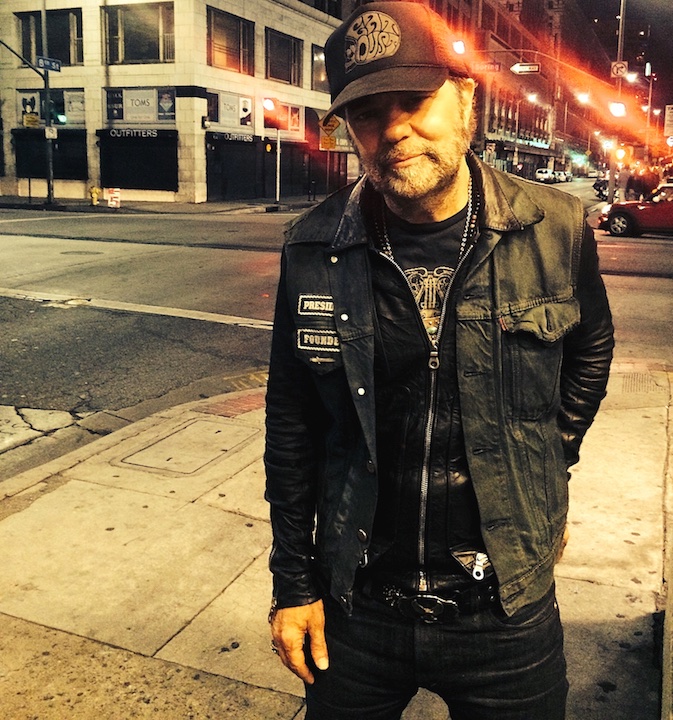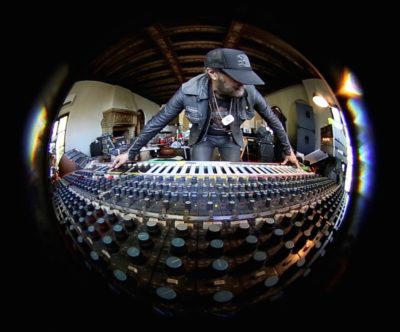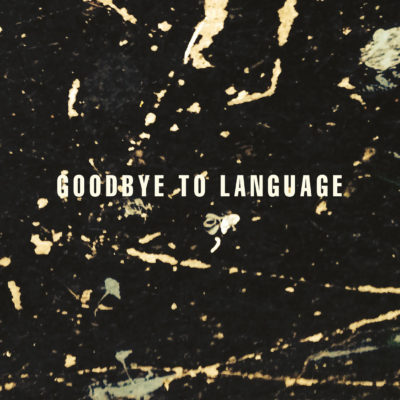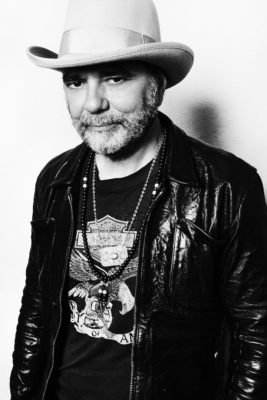Music Production Legend Daniel Lanois on Melody, Mixing and Starting Small
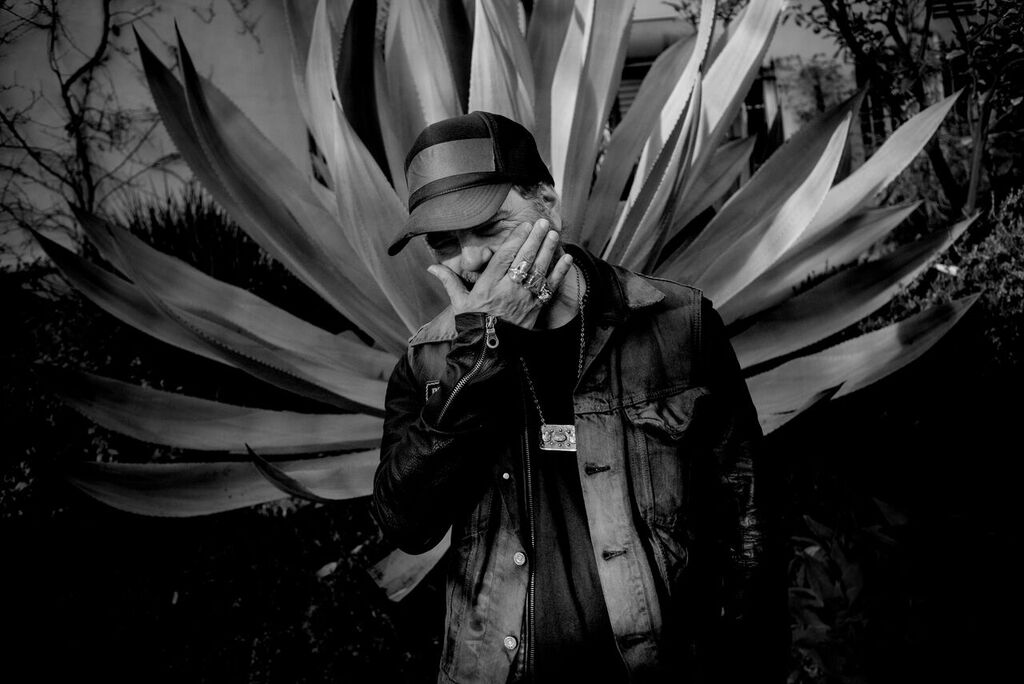
Daniel Lanois’ latest album, Goodbye to Language, a collection of atmospheric compositions for pedal steel and lap steel guitar, is out tomorrow September 9th.
It would be difficult to find a producer, engineer, or musician who hasn’t been influenced by the work of Daniel Lanois in some way.
Over the past few decades, the Canadian multi-instrumentalist, mixer, and producer has continuously released his own solo works while collaborating with an array of remarkable, world-renowned artists including U2, Brian Eno, Peter Gabriel, Bob Dylan, Neville Brothers, Emmylou Harris, Willie Nelson, Scott Weiland, Luscious Jackson, Robbie Robertson, The Killers, and Neil Young.
Simply being in the studio with just one of these performers would give even the most experienced audio professional enough to brag about for a lifetime, but Lanois is nothing if not humble about record-making. I reached Lanois in his impressive Toronto home studio and in our conversation, the soft-spoken sonic masseur was quick to remind me that “everything starts small.”
The story of Lanois’ musically adventurous life is a familiar one. Like so many visionaries, his tale is filled with a lot of hard work and a dose of luck. At a young age, he became fascinated with melodies, and for 10 years, he ran a studio with his brother in their mother’s basement in Ontario. After a group called the Time Twins went to New York and showed Brian Eno some of the recording they did with Lanois, Eno promptly called him up and asked if he would work with him too. This crucial relationship helped solidify Lanois’ path in recording, producing, and composing exquisite aural soundscapes for years to come.
Lanois’ latest record, Goodbye to Language, out tomorrow, September 9th, is a wonderfully expressive journey in exploring and understanding an instrument that he has had a kinship with since he was a child: The pedal steel guitar. This album, which also features lap steel performances from collaborator Rocco DeLuca, often resembles the ethereal productions Lanois did with Eno in the mid ‘80s. As Lanois describes it, the music is meant to be “symphonically beautiful and harmonically complex but also [have] sounds that you can’t quite pinpoint.”
In our conversation below, the legendary producer and musician goes into detail about the making of his new record, collaborating with Brian Eno, the secret to writing great basslines, and much more.
Your latest release, Goodbye to Language, revolves around two instruments that many people aren’t too familiar with the pedal steel and lap steel. They’re such haunting and memorable instruments on their own, and it sounds like there’s a lot of sonic manipulation going on to make these guitar sounds even more interesting. How did you approach putting this one together?
Yes, the raw performances are the two steel guitars. Once I had those performances, I went through them and I remained loyal to chronology, but still removed a few sections to make for a more streamlined arrangement.
Once I was happy with arrangement, I would go in and treat the steel guitar as source material [for] my little sampling and dubbing machines. I’d grab a fragment of one of the guitars and try to transform that into a fascinating external sound. If I succeeded, I would just drop it back into the track along with the source material to provide another sonic dimension.
There are many ways I treated these samples once I had them. Being that it’s derived from steel guitar, it’s viewed as cut from the same cloth, but a different blend or magnification of it. I might drop or raise something an octave. When I dropped them back into the track, that’s what made for some of the fascinating chord changes.
Some of those changes are really amazing. When you start a new song, do you often have specific goals in mind or do you not like to give yourself limitations?
On this record, we operated within some guidelines. We did decide not to use drums, synthesizers, or anything else. We wanted to stay with the pure form.
I didn’t want to make a particular record other than knowing that I like my steel guitar, and that was enough for me to operate by. We were just happy to be playing together. Coming off the road, people are always at the peak of their skill, so I wanted to enjoy the presence of my friend, Rocco DeLuca, and just play.
Was Rocco involved with Goodbye to Language since the very beginning?
I started with one track in Toronto, the one called “Deconstruction.” I was pleased with the result of that. When I hooked up with Rocco, I was happy to have him provide me with a little more bottom end than my instrument can go because he’s tuned down to a low D. I noticed that the recordings I did with him were covering the spectrum better than on my own, so I decided that would be a good companion to work with so I continued with him. All the other titles were co-writes with Rocco. “Deconstruction” was the instigator of the project though.

I’m guessing that the album title has to do with the fact that it’s an instrumental album. Is that the case?
Yes, that’s one onion skin of it. By going instrumental, you are speaking a universal language. I’m not suggesting to anyone that they need to speak English to enjoy the work. In some of the Eastern European classical writings and recordings that I’ve enjoyed over the years, there’s sort of a non-pop tonality to this that allows it to live on and it takes the listener on a journey outside of the familiar sounds of instruments. We tried to do something all original and without drums.
Not a lot of people play the steel guitar days, so it’s nice to hear it take such a dominant role on an album. You don’t hear so much of it today, though I suppose country music has some steel guitar in it still.
Yeah, it’s been used frequently in country music. There are amazing players that I’ve been humbled by when hearing some of the classics. I play slower but more melodic. I think I’ve found my own voice with the instrument.
That’s not the only uncommon instrument you’ve made your own. I’ve heard that you used to play the penny whistle a lot as a kid, is that true?
That was my first instrument. It was just a little plastic one that I got for a dollar. I played it for two years. As the story goes, my mom used to give me a dollar a week to go to the movies on Saturdays. On one Saturday, I saw the whistle in the window of a music store and I bought that rather than going to the movies. That was the beginning of it. It was exactly a dollar. I went in and the guy said, “Well, it will be $1.07 with tax.” I didn’t have the 7 cents but he gave me the whistle anyhow.
[Laughs] That was very nice of him. So how long did it take you to write and record Goodbye to Language?
We worked in short installments. The performance part with Rocco went quick. We did those in four sessions with each session taking about two days. And then the hard part of the work came by way of listening, editing, manipulating, dubbing, and deciding whether a title was worthy of making the finish line. There was a lot of material. The raw performance was about 15% of the effort, and 85% [of it] was rolling up the sleeves and doing everything else.
Were there any obstacles that you and Rocco ran into?
I don’t think there were any obstacles. Rocco was very encouraging of my manipulations, dubs, and sonic treatments, so that became the criteria of making the record.
There’s an interesting melancholic ring throughout the album.
Yes, it is quite dramatic sometimes.
Where does that come from?
Rocco’s Italian—that’s why it’s dramatic. [Laughs]
Some of us are just seekers, but as a friend of mine would say, “Once you fully analyze yourself and your work, you won’t be doing it anymore.”
[Laughs] That might be true. Still, I’m curious about your sonic taste, approach, and direction. What do you think has influenced it the most?
I’ve lived through a few different chapters of music, and I’ve held onto my inspirations through each of those chapters. I love Suicide and I’ve listened to Suicide now and again as an example of very soulful music that’s done with machines—just two guys part of a movement, part of that glam era in Manhattan. I never get tired of listening to Suicide and I like that they’re slightly obscure as a point of reference.
Any given chapter of music has something in it that I try to carry in my back pocket to find inspiration at least. We all love the streamlined songwriting of The Ramones, and I’m sure they were copying The Crystals from back in the day. A significant transplant sort of happened along the way. I’m not going to make a Ramones record, but I remember enjoying them [Daniel sings a Ramones-like melody]. It’s clear and simple. So whether it’s something like Suicide or The Ramones, it’s all in my memory bank and part of my skills and I can [call upon] that at any time.
On that topic of studio manipulation, the only people I’ve seen credited on albums as having done “treatment” to a song are you and Brian Eno. Was that a term you two came up with?
Brian Eno came up with that. In fact, he came up with the term ambient music. I was very lucky to be with him for about six or seven albums back in the day. It was a real part of my foundation. It was just a lovely time. We manipulated and treated everything. [Laughs] One technique we did a lot was abandoning the center of a composition. It was a deconstruction thing where you take part of the picture away and see what you have left. It’s an old Eno technique. It’s not necessarily unique to him though—a lot of people have worked that way historically.
There’s something great that Eno said in your documentary Here Is What Is: “Beautiful things grow out of shit.” Can you expand on that?
[Laughs] He was a little grumpy that day I interviewed him on camera. I think what Brian was trying to say is that there’s not a magic button or a magic wand. Maybe there’s a little glimpse of something that could become something much more grand. Don’t dismiss that little twinkle in the eye or that series of notes or riff. Everything starts small. As a gesture of respect, take notice of that and that might just be enough to go on. Something that comes up on its own that you pay attention to might just become your best friend. Everything that we’ve done has always started that way.
There’s a beautiful piece of music on a record called Apollo called “An Ending (Ascent).” It’s one of Brian’s best. It’s a real beauty. If you listen to it, you might notice it—it’s been licensed so much because it has a lot of spirit and soul in it. It’s just a solo performance by Brian on a Yamaha synthesizer. We fiddled around with it and it turned out to be a beautiful hymn.
Somebody might have said, “You need an orchestra, an arranger, and everything else to touch a lot of hearts.” Nope. He did it by himself. One synthesizer. One pass. There was a lot of effort put into doctoring it, manipulating it, and treating it but the source was ever so simple. I think instead of saying everything starts from shit, you could say, “Most things start small.”
[Laughs] Yes, that’s a nicer way of putting it. Apollo is wonderfully done. In the studio, you would often sculpt the sound with an EQ or other piece of equipment as Brian played, correct?
Yes, that’s one thing I would do. I had this graphic EQ that I had early in the chain coming out of the synthesizer, so it would hit my EQ and would then go to the rest of the recording chain. I could change the tone of what Brian was doing while he was performing.
He welcomed that because I was able to provide an expression that was apart from his choice of notes and chords. This is all a way of putting a little bit of harmonic shift in a sound that might otherwise have been static. It’s kind of a way of fooling the machine and giving it a little bit of extra soul.
When you’re writing and producing a song with an approach that’s so explorative and open-ended, how do you know when you’re finally done?
On the day of discovery and recording of a track, a rough mix will be made. That mix will then be put on an end-of-the-week listening CD. Later, we’ll listen back to our week’s work and there will usually be some standouts. Sometimes they’re tracks that we might not have been paying a lot of attention to before.
I’ve often been nicely surprised after listening back to a ‘work mix.’ But if a work mix has soul and gets the point across, it might very well be a final mix even if you carry on and do more work on the track.
Early mixes can have a lot of power, especially far out ones. I always had this technique with Eno where we’d work on a mix and then say, “Okay, that’s done. Now let’s do a film mix.” It was just a way of saying let’s really deconstruct it and see how far we can push it. Those far-out mixes were often the chosen ones.
When it comes to mixing, you have a console that a lot of engineers would love to work on. Is there a story behind how you found your Neve 8068?
That console has a long history of record-making. It originally belonged to Richard Perry, a record producer out of Los Angeles. I didn’t buy it from Richard. It fell in the hands of a dealer in Toronto that I bought it from. I used it up here in Toronto for a while. It’s been refurbished a couple of times. It’s in L.A. right now. I think it’s probably got hundreds of albums under its belt. I’ve used it with anybody that I’ve worked with. But even before me, Richard had worked with The Pointer Sisters, Leo Sayer, Rod Stewart, and many more.
Do you consider your console to be a musical instrument in its own right?
Different console operators have different talents. Some might be musical, some might not. I’m musical so I treat any mix like a performance. I’ve chosen to not use mix automation because I don’t want to just change a little thing about something I’ve already done. I’d rather have another go at it and have a fresh batch as those are often the most exciting.
Once I learn the position of the tracks, where they show up on the console, then it’s a little bit like the playing of an instrument. I don’t usually have much more than ten ingredients so I just jump in. I wouldn’t be the first one to work this way. If you listen to Remain in Light by the Talking Heads you’ll hear a fine example of what I’m talking about because they’re playing the console to build different sections of the songs and arrangements.

Consoles aside, is there any particular piece of gear that you were mesmerized by when you first saw or first heard it?
I’ve always enjoyed the VCO on my AMS harmonizer [AMS DMX 15-80s]. To this day, I keep an AMS maintained. It’s a machine I know well so I can actually play the VCO and enhance what might be otherwise a static sound. It’s a little like working with the equalizer during those Eno performances. I apply that concept to different sounds. It’s always been bit of a secret weapon.
There’s another producer who comes to mind that you spent a good amount of time with at one point—Rick James. He recorded some demos in your mother’s basement long ago. How old were you then, and what was it like to have Rick James in your mom’s basement?
That would’ve been the early ‘70s. A friend of mine named Eddie Roth made the introduction. I had never worked with anyone like that, a great all-around instrumentalist. He was a great singer, a great songwriter—really great at everything. I felt so blessed. I was in the presence of a modern Beethoven, a master musical mind.
I was very fortunate to be exposed to that absolute mastery. I can’t say enough about him. He played nearly all of the instruments. In about a half an hour, he’d have a track pouring out of the speakers. For me to be exposed to such a mind as a kid, I was very lucky. You could spend 10 years in a recording school and not learn what I learned from Rick in two days.
I don’t doubt that at all. I saw an interview you did a while back with another talented producer, Pharrell Williams, where you spoke briefly about learning how to construct great bass lines. What’s the secret to writing a fantastic bass line?
The first thing to remember is that a bass line can be the hook of a song. [Daniel sings the bass line to “Superfreak” and “U Can’t Touch This”, written by Rick James]. Those are the ones that live on. Our British friends stole the idea too. [Daniel sings the bass line to “Owner of a Lonely Heart” by Yes].
Listen to that song again and tell me what you hear in the bottom end. As a record maker, it’s a very significant part of the music. I think we can safely say that all masterpieces have a significant bottom end. [Daniel sings the bass line to “I’ll Take You There” written by Al Bell and made famous by The Staple Singers].
Absolutely. Speaking of British bands, Queen had some memorable bass lines. Are you a fan at all?
Yeah, I was always in awe of their harmonies. It was bordering on the kind of excellency I’ve heard from Bulgarian singers. There’s a record called Le Mystère des Voix Bulgares. It’s old Bulgarian folk music with very powerful and complex harmonies. It reminds me a bit of Queen.
I haven’t heard much Bulgarian music. When did you become interested in it?
I got turned onto it by Eno. I’m so glad that he made that introduction. It’s very emotional music.
Another artist that you’ve worked with a lot, Peter Gabriel, has delved into world music many times.
Peter Gabriel always had an interest in music from other parts of the world. He spent quite a bit of time in Senegal prior to my involvement with him. A lot of the English artists were sniffing around other parts of the world.
I’m friends with Robert Plant [of Led Zeppelin] and he told me that he and [Jimmy] Page used to spend a lot of time in exotic parts of the world simply to listen to what those people were doing. “Kashmir” came out of that.
They were definitely influenced by the folk and acoustic instruments of the East. Peter also always had that appetite. And I think that Ginger Baker [of Cream] was on top of all that even before Peter.
You’ve been all around the world yourself. If you had a time machine and had the opportunity to go back to one place to record a song, where would you go?
I might choose to go to New Orleans to be involved with the song “Working in the Coal Mine.” That would do. Yeah, I would want to be involved in a Lee Dorsey track. [Laughs]
What’s the most important piece of advice you could give about being a good producer, engineer or artist?
Well, I joke a little bit with this piece of advice but there’s some truth to it: No strumming! If you strum, you’re going to cover everything and you won’t have room for anything else.
Anything that gets played has to be a complement to something else. There’s never any filler and you can break it down the same way you’d read a classical chart on a manuscript. If there’s to be a French horn part, then there needs to be an underlying complement to that melody and so on.
I think having an understanding of how music is built [is hugely important], and it’s easy to study that by listening to your favorite records. If you can sing the bass line, sing the drum part, sing the melody, and sing the harmony, then that’s a pretty good start to understanding what music is about.
We can do that without school. There’s a fabulous education that’s available to anyone that has records and wants to take the time to dissect them.
Please note: When you buy products through links on this page, we may earn an affiliate commission.







